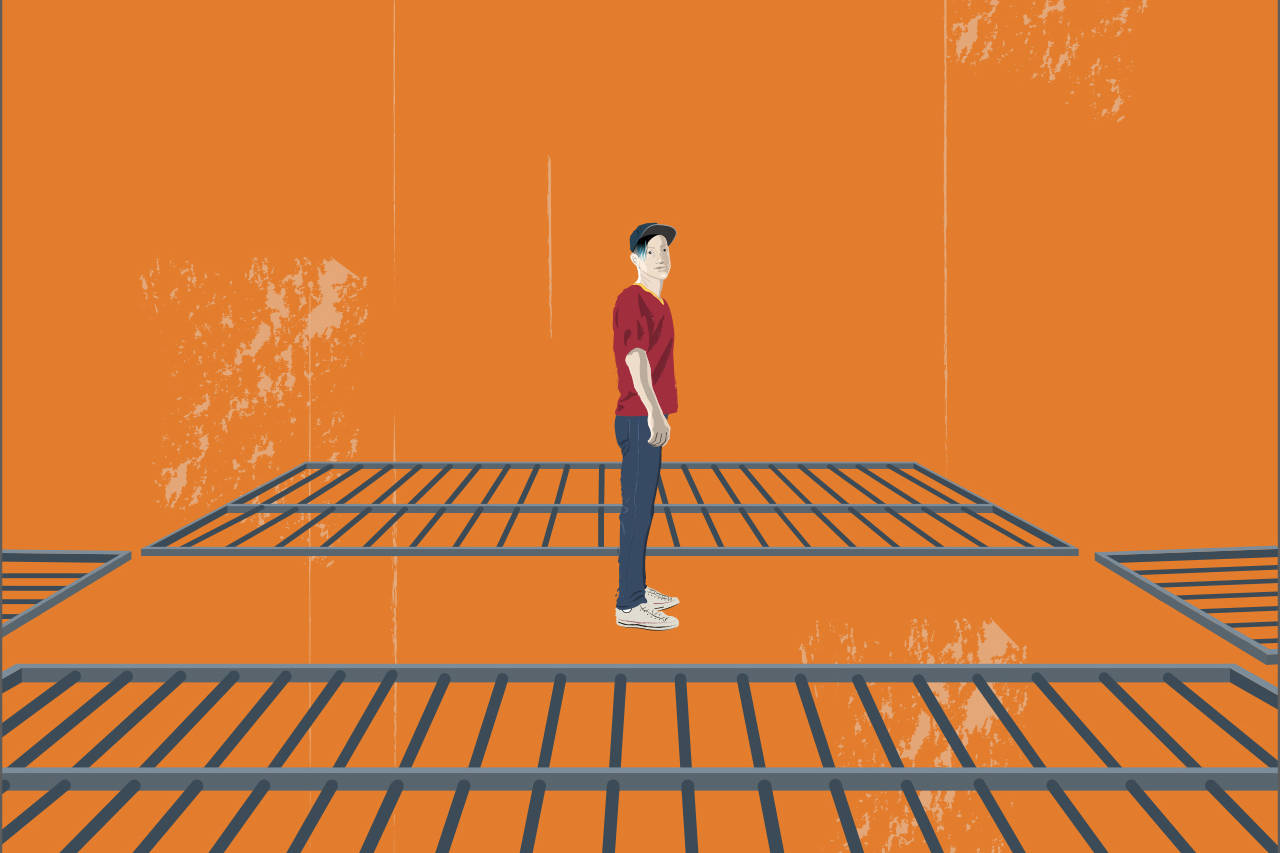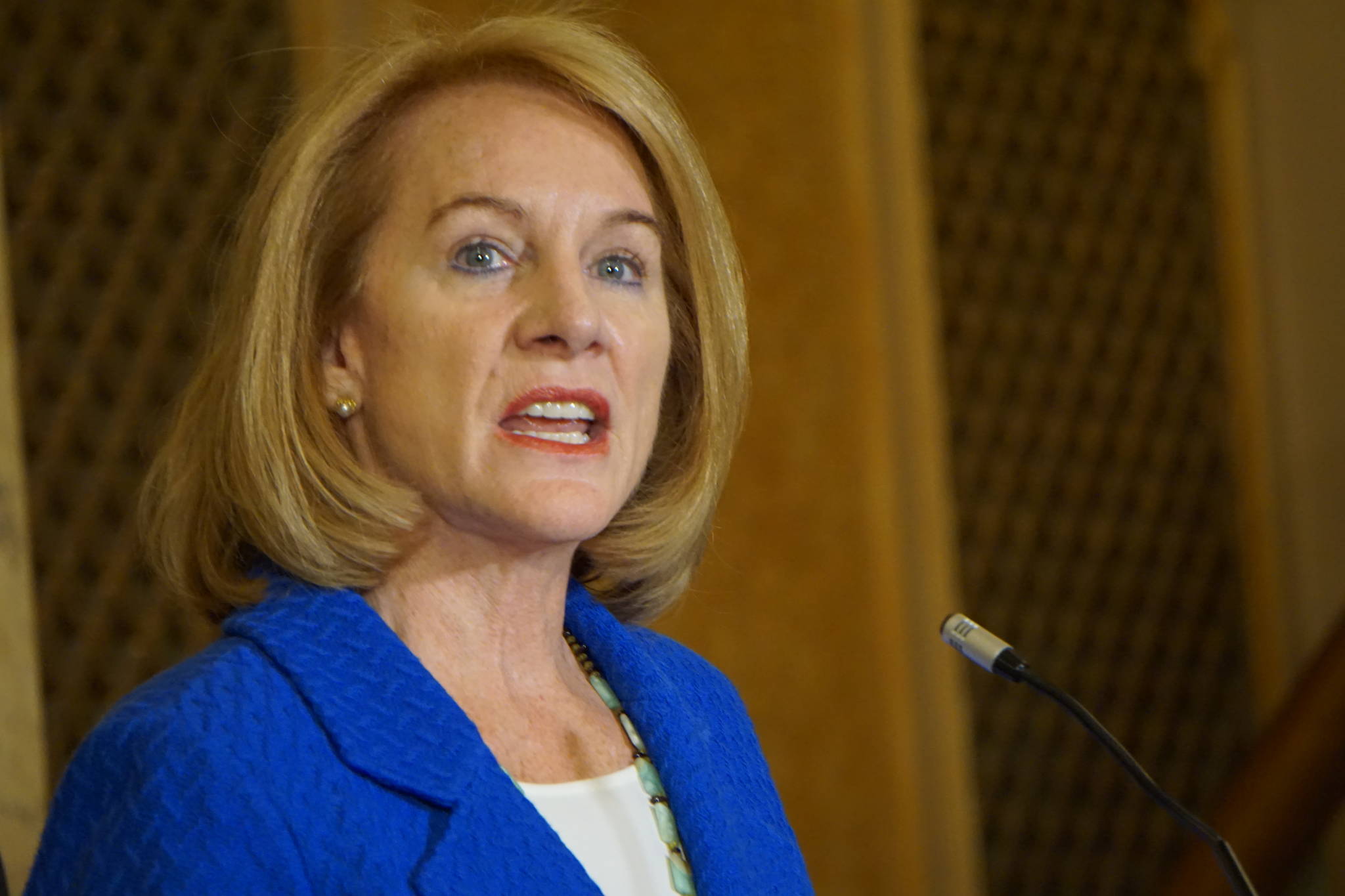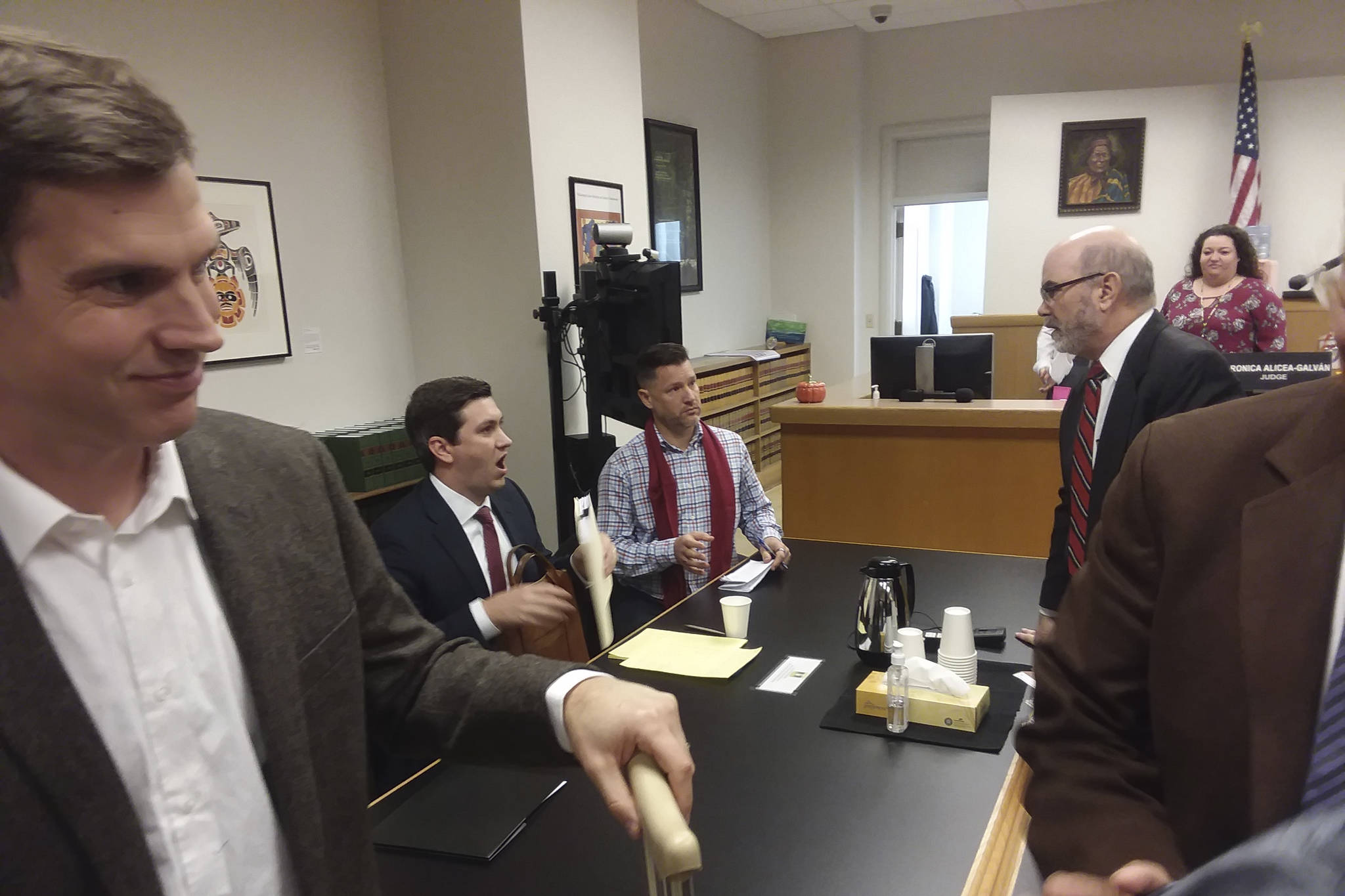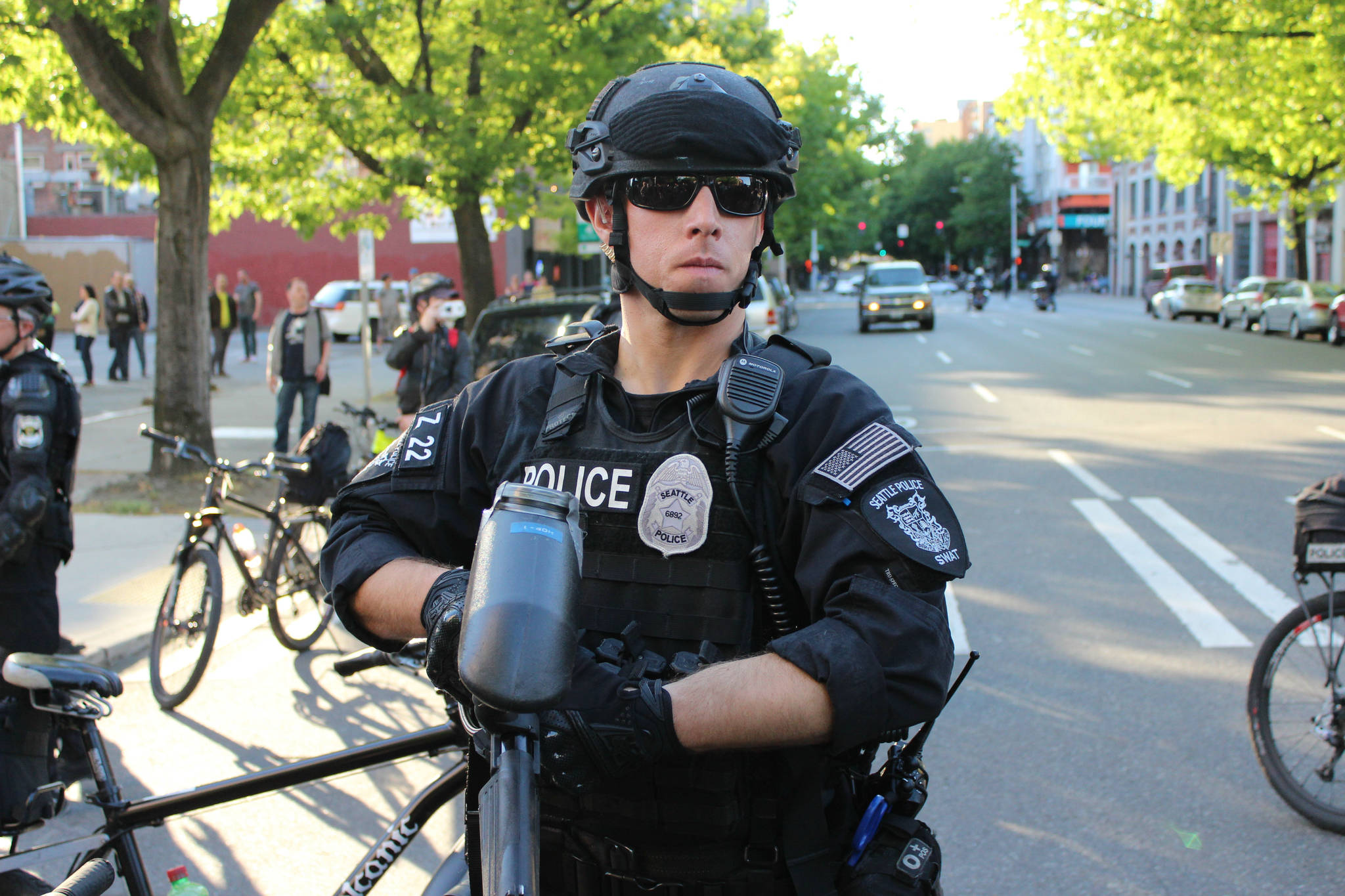On the afternoon of September 19, 2016, the full meeting of the Seattle City Council started and ended under protest. Near the beginning of the meeting, during public comment, about a dozen 20-something protesters dramatized the plight of children locked in the nearby county youth jail. Some wore cop hats and pig noses or patrolman sunglasses, and one guy had POLICE written on the front of his shirt. Others were chained prisoners, wearing orange coveralls, BLOCK THE BUNKER T-shirts, and/or tape over their mouths. Dozens of their peers sat in the audience, wearing shirts and holding signs that declared their opposition to the prison-industrial complex.
The protesters had reason to believe their theatrical tactics might work. The week before, the Council had bowed to pressure from many of these activists to indefinitely delay, though not cancel, a new, very expensive police station that the mayor wanted to build in north Seattle. It was an unprecedented victory for a new generation of anti-police activists dissatisfied with past compromises. They have found purpose in the steady flow of cell-phone footage depicting the killing of black Americans by police officers. Many, including the members of the No New Jim Crow Coalition, have educated themselves through the analysis offered by Michelle Alexander in her 2010 book The New Jim Crow. Using historical evidence, Alexander shows step by step how mass incarceration replaced explicitly racist laws as a means of controlling black Americans after the success of the Civil Rights Movement of the 1950s and 1960s, with the result that today more black men are behind bars than were slaves at any given time in the antebellum South. Add this grievance to the class resentment fueled by disparities in wealth not seen since the 1920s, and you’ve got the recipe for a genuinely revolutionary attitude, one that dispenses with compromise and aims to wholly remove and replace the complex of police, courts, and prisons that currently manage our society’s public-safety needs.
To many of these mostly young radicals, police and prisons are not any kind of solution. They are the problem. And on September 19, these activists wanted city leaders to go further—to actively work against a new youth detention facility planned by the county.
After the testimony from faux prisoners and guards, the Council moved on to its regular agenda. With much fanfare and mutual congratulation, the city’s legislators unanimously voted into law a secure-scheduling ordinance that gives workers the right to know their work schedule ahead of time, be paid for last-minute changes, and rest between shifts, as well as the right of first refusal to cover new shifts before an employer hires someone new. For a few minutes it looked as though the thunderous dissent that had hounded Council meetings in prior weeks was finally satiated. The north precinct was on hold, and anyway the new youth jail was King County’s project, not theirs. Speaking before her vote in favor of the scheduling law, Councilmember M. Lorena González held out an olive branch. “I want to thank you all for reminding us of the importance that you play in our city and in this movement for income inequality,” said González, gazing pointedly at the audience, “to make sure that we are held accountable to you all in that regard. This victory is your victory.” Cue polite applause from some audience members.
Seven minutes passed. The Council okayed some zoning changes. “Please read the next agenda item into the record,” said Council President Bruce Harrell to the clerk.
As she did, a piercing cry emanated from one audience member: “If we’re not heard we’ll shut it down!” The clerk missed a beat, then continued in a louder voice.
“If we’re not heard we’ll shut it down!” cried the voice again. The clerk stopped reading.
“OK,” said Harrell.
On the third try, several other voices joined in: “IF WE’RE NOT HEARD WE’LL SHUT IT DOWN!” Within seconds, dozens more voices added themselves, filling the room. Suddenly the faux guards began to shove the faux prisoners back up toward the front of the room. “We gotta get these convicts out of here!” one of them bellowed. “Get back to public comment!”
“Thank you,” said Harrell in jest. “Thank you, officers.”
“WE WANT PUBLIC COMMENT!” the audience began to chant. They paused briefly while Harrell tried to negotiate, but talks quickly stalled when he insisted on silence and the crowd responded by chanting over him.
“You’re giving me no choice but to adjourn the meeting,” called Harrell over the din. Silence obviously not forthcoming, he quickly made good on that promise.
Following the adjournment, most councilmembers left. But Kshama Sawant and Mike O’Brien remained in the chamber with protesters for more than two hours, with Harrell staying for part of the time and Lisa Herbold returning later. It was an odd sight: Protesters talked to leaders, who listened, then leaders talked to protesters, who listened. Amid these unprecedented discussions, organizer Nikkita Oliver told the councilmembers that “what’s happening right now is more productive than what I’ve ever seen, but it literally wouldn’t have happened if these folks hadn’t disrupted council meeting after council meeting.”
When she said that, Oliver had recently graduated from law school. Now she’s an attorney—and a candidate for mayor, under the aegis of the newly founded Peoples Party of Seattle. Part of its platform is the demand to abolish youth incarceration. In the short term, that means forestalling county plans to build the new $210-million-plus Children and Family Justice Center, which would include a new youth detention facility along with courtrooms and other facilities. In the longer term, it means investing in community-based social services to mitigate the extreme poverty that breeds criminality in the first place, and creating genuinely therapeutic alternatives to jailing youth.
Yet the reason opponents oppose the new youth jail—that our outdated, unjust, penal model of criminal justice needs to be replaced by a therapeutic approach that uses physical detention only as a last resort—also happens to be the reason the other side in the debate supports it. King County Prosecutor Dan Satterberg and others in county government say that the current facility in central Seattle, in addition to being old and leaky, is an architectural relic built to warehouse youth instead of rehabilitating them. “The first question I ask people who think we don’t need to build a new youth courthouse and detention facility is ‘Have you ever been there?’,” Satterberg says. “Because it’s a dilapidated, substandard structure that needs to be replaced.”
A new, “trauma-informed” facility, proponents say, would both symbolically and literally put the welfare of detained youth first. “We have this ability to build a building that’s going to last for the next 50-plus years that we can design with modern justice principles,” says Satterberg, who first worked in the current facility as an intern in 1984. “Why anybody would advocate to keep that crappy building for—well, indefinitely—is beyond me.”
Oliver, along with the many people beside and behind her, hasn’t yet won the day against youth incarceration. Far from it. The CFJC is still on track to break ground this year. And for most people, the idea of abolishing jails is tantamount to anarchy.
Yet the labors of the anti-incarcerators have not been in vain. Since they began their fight in 2012, a dynamic has emerged: activists demand the impossible, and leadership counters by offering a better version of the possible. The most concrete example of this is the reduction in the number of planned beds in the CFJC. Originally 212, it’s now down to 112, and all the units are built to be convertible to other uses.
The activists’ success can also be seen in the growing number of elected officials who have begun to publicly question the project. This spring, in an editorial in The Stranger, Harrell and County Councilmember Rod Dembowski both declared their opposition to the CFJC as currently planned, citing Dr. Martin Luther King, Jr.’s admonition to “awaken to the great revolution.” That same month, Seattle Mayor Ed Murray and King County Executive Dow Constantine both released public statements calling for the project to be reevaluated before proceeding.
And so the debate goes on, with both sides claiming to be motivated primarily by concern for the welfare of (potentially) jailed youth in King County. The conversation has evolved along the way, now centering less on what is desirable than what is feasible. There can be no question that youth jails—that is, cages for children—are morally repugnant. But the alternative—say, releasing a teenage serial rapist and hoping for the best—can be worse.
So youth jails are evil. But are they necessary?
If you’ve ever been to an older public school, you already have a sense of what the King County Juvenile Detention Center looks like. It is part of the current Youth Services Center, a couple of brick boxes built in 1952 that also house Juvenile Court and its services, as well as juvenile divisions of the Prosecuting Attorney’s Office and the Department of Judicial Administration. Specifically, a one-story building is set in front of a brutal multistory concrete mega-box with slit windows that look a bit like the black keys on a piano keyboard. There’s lots of parking, some unused lawn space, and trees along the sidewalk to partly obscure the architectural mass behind them.
Visitors enter the facility through the same kind of push-to-open, self-closing doors as are found in public schools. The worn floors are the same mottled, buffed-over concrete that reflects the glare of the fluorescent lights overhead. Immediately upon entering, visitors pass through a metal detector and bag scan, as at the airport or the county courthouse. Dozens of sparsely cushioned office chairs are arranged in three rectangles surrounding an open lobby. Alexa Vaughn, spokesperson for the county, says that one of the current facility’s many drawbacks is a lack of private spaces for families to consult with lawyers—and indeed on the day I visit a family is consulting their lawyer in hushed voices at a table at one side of the lobby. She adds that the building also has bad ventilation and that some of the courtrooms are so small, she says, that “many times people can’t fit their entire families.”
I’m not there to see the courtrooms. I want to see the jail. Juvenile Detention Center Director Pam Jones guides us through her dominion, along with Jameelah Cage, project manager for the new CFJC. The youth detention center, too, looks like an old high school, but with locks on every door and window. The walls are made of concrete blocks painted white. Occasionally, boys wearing neon sweaters walk past us silently in single file, accompanied by a guard. We walk through the halls and down a flight of stairs that, during a 2008 flood, Jones says, resembled Snoqualmie Falls. We visit the youth jail’s library, in-building school, and gymnasium, which looks like a regular middle-school gymnasium. Jones says they celebrate Christmas here every year. “Kids don’t want to leave during the holidays, because it’s a special time here,” she says. As for the building’s fabled damage, there’s not a lot to see: just cracks in the ceiling and windowsills that pool water. “At this point, it’s not visual, it’s pipes” and other hidden troubles, says Jones.
The current youth jail has 212 beds divided into 15 living halls for housing young prisoners. Each hall includes cells, a common area, some hallway space, and a small courtyard detainees can access at certain times. Due to underpopulation, many halls are closed off, while others have been converted to other uses, such as an activities room for detainees and a break room for staff. One hall has been converted into a non-detention rest center called Family Intervention and Restorative Services, or FIRS. FIRS gives youth in crisis a place to cool off and get some distance from their home environment, then facilitates talks among family members to help address the underlying causes of their problems. The concrete-block walls inside the FIRS hall have been painted with vivid illustrations of outdoor scenes in bright colors. There are some books and a computer station in the common area.
In addition to FIRS, the county has other alternatives to youth detention. Examples include Peacemaking Circles, in which offenders, victims, and other affected community members, under the supervision of a judge, engage in a facilitated conversation concerning how an offender should make amends for a transgression; and restorative mediation, also a facilitated conversation but in a smaller setting, in which “non-violent offenders understand the full impacts of their actions directly from victims.” Executive Dow Constantine recently proposed creating “Safe Spaces,” which would “divert more young people from detention by providing 24/7 community-based services and short-term emergency housing for at-risk youth and those involved in the justice system” across the county, according to a press release. Also, the 180 Program allows youth to get their charges dismissed if they complete a workshop “that helps them work through personal struggles that may be leading to misbehavior,” according to a county handout.
Youth are detained at the current jail for a variety of reasons, from felony assault to misdemeanor drug crimes. The most common cause of admission last year was felony “person crimes,” which primarily involve putting another person’s body or safety at risk, and can include the use of a firearm. Next on the list is probation violations, followed by offender warrants for not appearing in court or for violating release conditions, runaway minors, and misdemeanor person crimes such as fighting. In short, many of the young people detained in the youth jail are not dangerous, but more than a few of them are. “We have a big problem in our community with young people and gun violence,” says Satterberg. “Last year we had 10 people under the age of 18 who were charged with first-degree murder or homicide… . Almost all were a case of gun violence.”
These are some of the cases that, in the view of Satterberg and many King Countians, necessitate youth jails. And it’s not just necessary, in their estimation; it’s appropriate. If you rob someone’s iPhone and wallet at gunpoint, says Satterberg, “you should expect to be held in detention because you violated society’s norms in a very, very serious way.”
This doesn’t fly with Oliver and other youth-jail opponents, who point to research showing that the more contact a young person has with the criminal-justice system, the more likely they are to return. Satterberg agrees, and points to the county’s relatively low rates of child prosecution and its various pre-trial diversion programs as evidence that county leaders are already leading on this issue. And he’s right: Compared to some of the punitive nightmares in other parts of the country, King County is a relative daydream.
But “better than Alabama” is a much lower standard than “as good as possible,” which is what the anti-incarceration activists want and what we all should demand. Which raises again the question: Are youth jails necessary?
“Zero incarceration is not crazy talk,” says Seattle City Attorney Pete Holmes, “but it’s important to understand that it’s an aspiration.” That aspiration can serve as a beacon when deciding what direction to move policy, he says, but in terms of actually getting there, “I don’t see the no-jail scenario in our lifetime. In that sense it might be utopian.”
I interview Holmes in his office on the 20th floor of the Columbia Center. His hair is silver, his tone friendly and businesslike. His pale face boasts the nose of a falcon. Behind him, downtown Seattle’s skyscrapers are framed by the wavy gray lines of Elliott Bay and the distant homes of West Seattle.
At 61, Holmes has already convinced voters to elect him twice, and he is currently facing a challenge from Scott Lindsay, former public-safety advisor to Mayor Ed Murray. During his first term, Holmes helped effectively decriminalize marijuana in Seattle. He also reduced all misdemeanor sentences to 364 days in order to avoid triggering federal involvement and thus potential deportation for undocumented immigrants. He is also the top lawman in a city that outsources its child-jailing needs to the King County Juvenile Justice Center.
Holmes says there’s a lot of room between abolishing incarceration and our country’s current status as the world’s biggest jailer, and critics of the current system should all be able to work in one big tent together without getting hung up on the wedge issue of whether zero incarceration per se is realistic. “The default setting today,” says Holmes, “ … is if you have a problem you call a cop, and the limited tools that police officers typically have [lead them] to make an arrest. And at that point we’re talking incarceration. Whether there’s an underlying mental-health issue, drug issue, whatever—fill in the blank, perpetuation of institutional racism—those kinds of things tend then to get short shrift. People address the immediate irritant, the disorder or whatever, [and] impose a short-term punitive measure. And then I guess we’ve become accustomed to [believing that] you can’t really fix the underlying [problem], or that this is good enough.”
Holmes is part of a growing chorus of establishment voices challenging that belief. The big question, he says, is “How do we make incarceration the option of last resort? … I think that would force us to address underlying social, public-health problems, [and] would lower incarceration on its own. We’d be forcing ourselves to look at what really works as opposed to simply warehousing problems.”
For all the power of his bully pulpit, though, Holmes has no formal authority over the county jail project itself, and by law his office does not handle criminal cases involving minors. Those go through the county and the authority of Dan Satterberg. A barrel-shaped man with wire-framed glasses and dirty blond hair that’s balding on the top, the King County Prosecutor is a Republican, but not of the Jeff Sessions variety. For instance, Satterberg is an outspoken advocate of criminal-justice reform and supports the current proposal by county public-health experts to create pilot safe-drug sites as part of a larger treatment-based response to the ongoing heroin/opioid crisis.
Satterberg is more skeptical than Holmes of the idea of zero detention, for youth or adults. “Can we ever have a society, a county where millions of people aren’t violent to each other anymore?” he says. “It would be a nice dream to have, but it hasn’t happened yet… . There’s always going to be some need to detain adults and youth who are violent to other people.”
The prosecutor enthusiastically supports the CFJC. “More than half the work that goes on up there is dependency work” involving child custody in cases of alleged abuse or neglect, he says, referring to work done in the courtrooms. “It’s very important work, overshadowed by all this conversation about youth detention.”
Satterberg points out that state law requires the county to have a youth jail to ensure that juvenile detainees are not locked up with adults. “I see [the new youth jail] as a symbolic, physical place to protest,” he says, “against a general sense of injustice within the criminal-justice system that goes back hundreds of years in this country—yeah, I get that. But I think it’s shortsighted because the building that people are fighting to preserve is not worth preserving… . The [new] building itself is absolutely needed. It’s required by law. We have the financing. Let’s start now.
“There’s a lot for us to do” to reform the criminal-justice system, he says, “but we’re always going to need a place for kids to take a time-out.”
Heirius Howell was one of those kids. After his family moved from Chicago to Seattle while Howell was young, they bounced between homelessness and transitional housing for half a decade, according to the Seattle Globalist. Howell told reporter Taylor Winkel that starting at age 10, he was locked up inside the current juvenile detention center maybe 14 times as a young man. At one point, when he was 12, he said, he spent every weekend for two months serving time. When he was 15, he said, he was found guilty of being an accomplice to armed robbery because he refused to tell authorities who actually did the crime. Between the sentence for that case and then another robbery charge later, Howell spent roughly a decade of his life in jail by the time he’d reached his mid-20s, he said.
In that 2015 article, Howell told Winkel that he opposed the CFJC even though it ostensibly will be built to benefit kids like him. “If you have enough money to build a new youth jail, you have enough money to change a kid’s life,” Howell said. “Instead you lock them up. You’re telling them you don’t care about them … and you don’t want to take the time to find out what they need.”
Howell is, of course, not alone in this view. Opposition to the CFJC is an enduring cause célèbre among Seattle’s social left, and the project has come to symbolize, as Satterberg noted, the new Jim Crow writ large. Last December, Nikkita Oliver and fellow activist Gyasi Ross triggered a discursive dust-up when they co-authored “So, What Do We Do With Youth Who Attempt to Kill?” in the South Seattle Emerald. Rather than answering that question, the article argues that such questions are “really just fear-mongering” and should be “reframed” to ask, “What do we do with an inequitable and ineffective system that actually perpetuates current negative outcomes and increases the likelihood youth will attempt to kill?” A small flurry of pro and con articles and online arguments ensued.
Earlier this year, I sat down with Oliver at Top Pot Donuts in downtown Seattle. Her hair was cut in her trademark style, shaved above the ears. Oliver speaks in a steady, reserved tone. A biracial East Coast native, she moved to Seattle to attend Seattle Pacific University. There she caught the activism bug, and went on to earn a J.D. and M.A. in public education at UW on a full-ride scholarship for budding public servants. An accomplished spoken-word poet, Oliver is nowadays a case manager for Creative Justice, a nonprofit that advocates for arts-based alternatives to incarceration, in addition to her current mayoral bid.
We sit at a table. On the sidewalk outside the building’s sheet-glass front window, a steady stream of pedestrians bob past. I ask Oliver: So you think we should just let every youth go, no matter how vicious their crime?
No, she replies. “Oftentimes,” says Oliver, “those of us who are pushing against the jail are painted as if we’re saying, ‘Let’s go tear that thing down today.’ ” But that’s wrong, she says: “It’s reasonable to say, ‘We need to deal with where we are right now, not double down on it,’ but also acknowledge that we’ve established a system [of incarceration] … and in order to build our way out of it, the status quo is the answer for some cases for now.”
In other words, for Oliver, #NoNewYouthJail amounts to #YesOldYouthJailForNow. In the long run, the existing facility may need to be replaced, but that replacement shouldn’t just “double down” on existing harmful models of detention with a newer, better jail. The replacement should be a wholesale reinvention of how we as a society deal with public-safety threats involving minors.
So what do we do with youth who attempt to kill—and, it should be noted, sometimes succeed? Oliver says she thinks “incapacitation” is sometimes a necessary tool of last resort for handling youth in crisis who present a clear threat to themselves or others. That is, she’s OK with forcibly detaining youth in extreme cases, but not in the manner in which the current criminal-justice system does so. “I think there are times when it’s important to, if something has gone down, you do need to remove a person from [a] space,” says Oliver. In a sense, she means that she’s fine with jailing someone as long as it’s done as humanely as possible.
But she resists such characterization. “You could say, ‘Nikkita, would you accept a jail if we do this?’ ” says Oliver, but that would miss the point. “Jails are, by nature of the way they’re constructed in this country, not therapeutic, not rehabilitative, do not provide restorative opportunities,” she says. “Current jails we have are not incapacitation in the sense of positive incapacitation,” she says. “They cause trauma, and that person is less likely to be in a position to be restored to society. I think figuring out ‘What does incapacitation look like that is actually rehabilitative?’ is really where we have to go.”
For Oliver, positive incapacitation might look, for example, like a supported-living residential facility that can be locked down when necessary—sort of like FIRS, except with a lock on the door. A key feature of any genuinely rehabilitative facility, though, would be physical separation from courts, cops, and other tendrils of the new Jim Crow. It’s hard for many youth to feel safe in the same space where they’ve been reduced to a security problem. Of course, the whole point of the CFJC is to co-locate everything related to youth justice in a convenient one-stop shop.
“If we were to actually create spaces,” says Oliver, “where young people can care for their body, care for their mind, care for their spirit—and in those instances where a young person does need to be separated from the environment that they’ve been in, that’s brought them to this hard place, and they can be brought to an environment that allows them to take care of themself—that’s a therapeutic space I would support.”
For the average Seattleite, the possibility of achieving zero youth incarceration looks distant at best. Yet, recent history suggest we might be closer than we think.
Abolitionists point to multiple examples of alternatives to jail that have had at least some success in practice. Kitchener, Ontario, launched a victim-offender reconciliation program in the 1970s after a probation officer experimented with the idea. In the late 1980s, another version emerged in New Zealand after Maori families objected to their children being seized by courts, according to the International Institute for Restorative Practices. Models differ, but two elements are essential: an open-ended conference among stakeholders about what should happen, and ongoing support for (and social pressure on) offenders to keep them from reoffending. Involving the offender’s friends and family is often critical to both goals.
Using such strategies, a team of youth-intervention professionals believe that zero incarceration—for children, at least—could be achieved in just a few years. Anne Lee of Team Child, Janis Avery of Treehouse, and Terry Pottmeyer of Friends of Youth have been working in consultation with UW’s Dr. Sarah Walker to bring forward a concrete plan “that could achieve zero youth incarceration in the next few years” among King County youth, according to a draft of their report. Instead of jails, the report contemplates “Crisis and Stabilization units” in different parts of King County where youth in crisis could be temporarily detained in a therapeutic environment. The plan emphasizes the importance of preventing youth from coming into contact with the criminal-justice system in the first place.
For the minority of genuinely dangerous young people who remain, the report exhorts the county to build on its current best practices. “While FIRS provides a good model for expanding the number of cases handled outside of formal detention and justice involvement,” it reads, “Washington State also has examples of home- or dorm-like placements for youth adjudicated with the most serious offenses.” The facilities managed by the state’s Juvenile Rehabilitation Administration, a part of DSHS, serve youth with “the most serious adjudicated crimes, including felony level robberies, burglaries, manslaughter, and murders.”
Almost all of those facilities are on “open campuses where youth live in dorms with carpet, common living spaces, and personal belongings in rooms.” Staff are trained in therapeutic practices including Dialectical Behavior Therapy, “in which youth are engaged in daily skills groups, set personal goals and staff are trained to actively monitor and coach youth to prevent aggressive incidents.” If executed, this could step further away from the old, punitive model of youth justice and toward a genuinely rehabilitative alternative. The devil would be in the details, of course.
Whether and how the county will get there depends in part on how much pressure they receive from constituents, and there’s little sign that Oliver and her comrades will reduce that pressure anytime soon. Though largely regarded as a long-shot candidate, the mayor’s race is now dynamic enough that a path to victory for Oliver is conceivable. And with or without Mayor Oliver, the path to victory against the new youth jail got a little wider yesterday, when Seattle City Council passed a bill that will allow an administrative judge to consider an appeal against the project. Stay tuned.
cjaywork@seattleweekly.com








